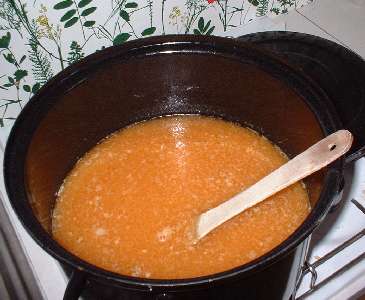
Curd Soap Process |
The original soap makers produced their soaps in a way different from today’s amateur soap boilers. Using the original terminology most of us today make "crude soap" (german: Leimseifen). Contrary to this the original soap craftsmen produced "curd soap" (german: Kernseifen).
If one adds salt to soap mass which is boiling in lots of water, one can see that the mass floating at the surface of the pot is much harder, thus curdier, than it would be without salt addition. This was the origin of the word curd soap.
More than one hundred years ago the starting materials for soap-making were not as pure and perfect as today. One worked with waste fats and knew nothing about the purity and the degree of dilution of the lye. Lots of excess water and long boiling times were used to eliminate contaminations. One would add lye at will or might decrease the amount of lye by adding fat. At the end a loose soap mass was floating on top of the water in the pot. Then one had to apply salting to separate excess water from the soap. The heavy saly water and lye, called ‘bottom lye’, remained at the bottom of the pot after cooling down, and on top floated a thin, sticky layer of still unfinished soap. Above it all was the soap curd, which – as said before – was hard and curdy and contained good soap. On the very top there may have been a foamy layer, which had to be removed.
The soap recipes in cook-books or household guidebooks often dealt with this curd soap process. Often even the lye had to be made by putting water onto collected wood ash. Without chemical analysis it was not possible to determine the alkalinity of the lye. In factories one measured at least the density of the lye with an areometer. Such apparatus, of course, could hardly be found in a household.
An interesting hint how to measure ‘density’ in a household could be found in a recipe for the preparation of lye: "One shall cook until an egg can float on it". In pure water an egg sinks, but in a reasonably strong or dense lye the egg would float.
The curd soap process therefore always assured a good soap as an end product. Only after coconut fat had been imported in larger quantities, soap makers discovered that self-heating during saponification was large enough to allow turning off the boiler heating. Thus the term cold process (CP) was established. The cold process is very simple, especially if one uses high-quality fats and pure caustic soda as starting material. This reduces the whole chemical analysis to simple weight control. All additives, if weighted accurately, guarantee a good soap. It is understandable, why today the cold process is favoured among amateurs, also because of more positive side effects such as superfatting and mainly, because traces of glycerine make the soap milder and more protective for the skin.
Still, it may be both interesting and exciting for today’s amateur soap maker to try out the old curd soap process and to once produce soap according to ‘old-fashioned’ ways.
Curd soap is NOT A GENTLE SOAP. Curd soaps are not too rich in fat or superfatted and, in contrast to cold-stirred soaps do not contain natural glycerine. Humans with sensitive skin should not use curd soap for washing the whole body. It is known that in former times curd soap was mainly used for washing cloths. ‘Gentle soaps’ were invented for washing the body. These were curd soaps filled with protecting fatty additives such as lanolin as well as perfume and pigments by use of so called ‘piling machines’.
The basis is a 19th century recipe from my aunt Emilie I have found. It is written in German in an oldfashioned style in one´s best handwriting. As is often the case with cooking recipes not much can be found except a description of the additives, which requires a bit of prior knowledge.
Glueing is an old special term among the soap makers. It describes the chemical process of soap formation from fat and lye. The result is so-called soap glue (crude soap).
Add into the pot about 3 litres of distilled water (our ancestors used pure rain water) followed immediately by 2 kg lard or suet. Heat the water, until the fat melts and the oil layer covers the top.
Afterwards dissolve CAREFULLY 390g caustic soda in 1 litre of distilled water. (Thus about 10 g caustic soda should be left over for later usage).
It is a basic rule in chemistry never to add water to a concentrated lye or acid. Rather always add concentrated lye / acid to water. If done wrongly the lye will strongly overheat. It can spill out and cause chemical burns.
During dissolution of caustic soda in water corrosive vapors can evolve. One should therefore care for ventilation. For safety reasons the pot with distilled water should be placed such that nothing can be spilled. For example in a wash basin, where nothing can happen, if something spills over.
Now it starts to get exciting: One pours the pot with the dissolved lye CAREFULLY into the big pot with the fat. The mass will immediately assume a milky-yellow-brown color, as a sign of the beginning of saponification. Stir with the spatula: ATTENTION; DO NOT SPILL. The use of the stick blender can help to save time.

One further heats the mass during steady stirring until it starts to undulate strongly. Now one should reduce further heat transfer to prevent strong boiling up or even spilling over. Stirring prevents overboiling and leaking of the mass . This also happens often, if one leaves the lid too long on top of the pot.
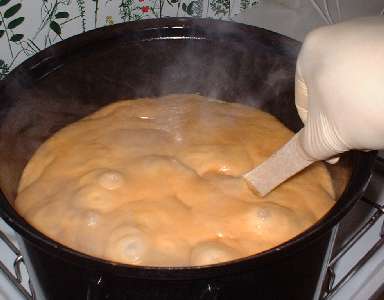
One will notice during stirring that the mass will become thicker and more and more like apple sauce. Depending on the intensity of stirring after half an hour or more the soap will separate from water. The mass now has the appearance of thin jam or marmalade. Also some chemical self-heating occurs, and one will have to reduce the heat transfer.
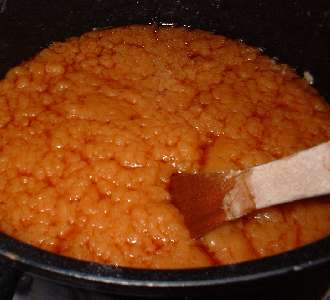
We continue stirring for safety reasons, because we want to get complete saponification of all fat molecules.
If one now removes the pot from the fireplace, one can observe the chilling of the surface and the appearance of an almost usable yellowish curd soap as crust.
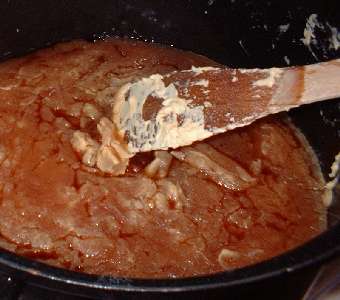
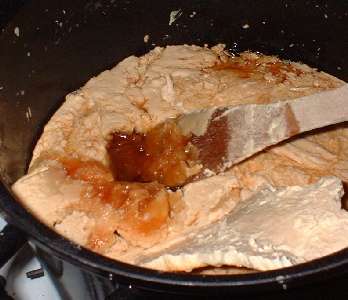
Formerly soap in this condition was called crude soap glue. It is strongly saturated with water and must be precipitated from water by use of salt.
If the mass is still hot, one can add about 300g table salt into the pot, which is again put on the fireplace. Salt cools the mass, it should start to boil again. One stirs on and off until one notices that the saltwater – properly called bottom lye – moves through the mass.
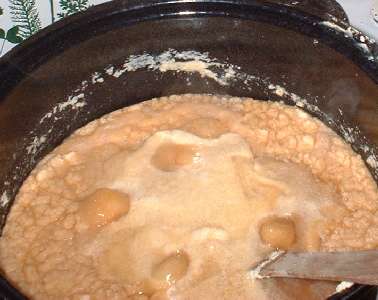
Boiling causes washing out of excess lye as well as impurities of the fat and and keeping it in the bottom lye. One should now remove the pot from the stove.
The soap practitioners discovered this way a process of separation and cleaning, by which the soap can be separated from the lye with the help of table salt and much water.
Following the recipe of ‘aunt Emilie’ one should now begin with pouring of the soap into the mould. See last chapter ‘moulding’. The problem here is the large concentration of lye in the soap. Because of this housewives left the soap rest and dry for many weeks. During this process also the last droplet of oil and the last fat molecule combined with the lye, whereby the soap became gentle week after week.
If one is still not pleased with the soap because of its high lye content he is advised to leave the pot standing over night and to let it cool down. The following day a hard layer should be on top of a brown liquid in the pot. One slices through the hard top layer and lifts it out of the pot and onto a cloth to dry it off. One should wear rubber gloves for SAFETY REASONS, because the bottom lye is strong and would cause burning of the skin, if one doesn’t immediately wash hands with water.
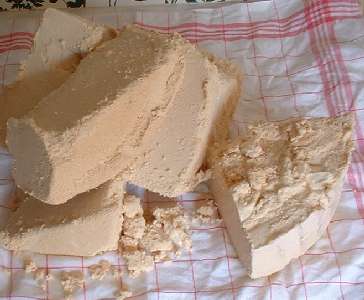
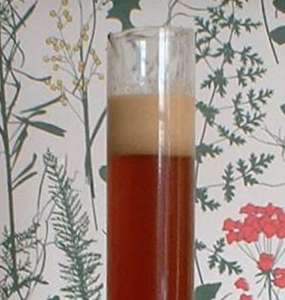
During fat or suet saponification the bottom lye has a typically dark red-brown color in the measuring glass, as one can see in the right picture. It contains also glycerine besides excessive lye and salt. It is a chemical separation product stemming from the fats used, which according to the chemical term are called triglycerides. Each molecule of glycerine carries three (tri-) fatty acid molecules. These combine together with caustic soda to the desired end product, the soap. Glycerine gets lost during the curd soap process, and this is one of the reasons why curd soaps are not protecting the skin. However, professional soap makers could distill out the glycerine, and they could sell off the bottom lye. Glycerine, since the invention of dynamite (nitroglycerine), has become a valuable starting material for making explosives.
One may be surprised how much soap can be made from 2 kg fat. During this experiment almost 5 kg soap were made. One should not be fooled, however. Such a soap still contains lots of water. It would later shrink considerably. It further has an excess amount of lye , because it floated on a heavy bottom lye. We thus must start the next process, the next separation by salt, in order to make the soap denser and more neutral.
The soap now has about 2 litres water too much, which have to be boiled off. Salt attracts water, and saltwater is also heavier than pure water. The soap floats on top of the saltwater and thus also separates from the water which it contains. Furthermore the soap shall be well washed out in order to wash out the excess lye.
Then a lot of distilled water, about 2 litres, will be added, and the mass will be boiled up again. There one can observe, how a nice and clear soap glue rises along the hot walls of the pot. If one boils large masses like in the industrial process, e.g. one hundred kilograms or more, the heating occurs very slowly, and the soap will be transformed into a nice, gluey mass. In the small household pots and with little patience the soap will boil and foam more violently, leading to a whitish mass, out of which the golden-yellowish bottom lye breaks through occasionally.
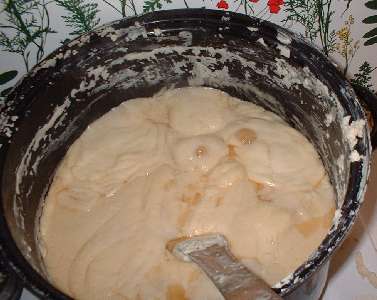
Now one adds about 300 g of table salt and the mass will be stirred uniformly. It cools slowly by dissolution of salt and starts to visibly segregate during further boiling.
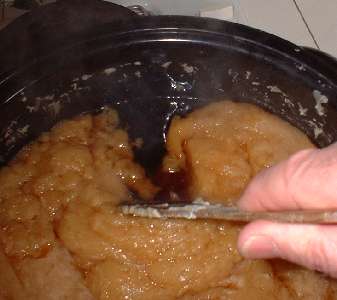
At this stage one can decide again, if one should siphon off the soap from above and pour it into the soap mould, or if, following soap maker tradition, the soap will be once more cleaned, in order to let it solidify in this specially cleaned mould.
One can now stop with boiling of the soap and fill this mass into the mould. See also last chapter ‘Moulding’.
It is definitely better to let the soap solidify during the night. It will float again on top of the bottom lye and solidify. If one separates the soap disc one can see that it has become thinner than after the first cooling down. One can learn from this that it contains already less water and thus has also become denser and more stable.
As before we continue now with the process. The soap melts in 2 litres of distilled water and will be well ‘cleaned’, thus it will be washed through in bubbling water. Then about 300g salt will be added, the soap will be stirred thereby loosing water and lye, which stay in the bottom lye. The disc which can be separated next day should now be solid and practically pure white.
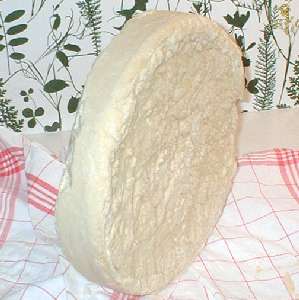
Clear Boiling of soap is the most critical part of the process during curd soap processing. For best results in casting the soap into a mould one needs a smooth and honey-like consistency of the hot soap. Doing this one has to avoid the soap from becoming foamier. Thus one should boil slowly while adding a hot salt/lye mixture.
One should prepare this mixture on time. Following this recipe 10 g of caustic soda and about 75 g cooking salt will be dissolved in half a litre of distilled water. This mixture shall be hot when more and more of the melting soap mass will be added .
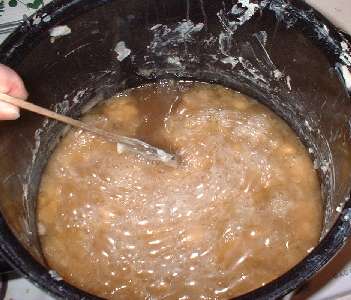
One must not be too impatient now and boil too strongly. This would again generate a lot of foam, which would make the soap to weak and too loose. One should allow about one hour for boiling. During careful boiling and gentle, slow stirring the loose soap mass will be dissolved, until ideally it will float as a gel-like mass in the pot and generate soap bubbles at the surface which can be heard popping up. The bottom lye should only gently penetrate and spread over the surface as a transparent soap layer. Too strong boiling generates too much foam.
There is always the danger of the soap getting too ‘acid’ in the curd process. The soap is then too ‘alkaline’, e.g. it has too high a percentage of lye, which can be measured on the pH-scale. Curd soaps typically have a pH 10. The value can be measured with a pH-test strip or electronically with a so-called glass electrode.
In soap boiling one knows since about 100 years phenolphthalein, which permits an easy and reliable pH-test of the soap. A few drops of phenolphthalein dissolved in alcohol spread over the cold soap mass generate a dark-red color, which shows that the soap has a pH-value larger than 10, and is thus more alkaline than necessary. A well boiled curd soap, on the other hand, will show a light-pink coloration.
The picture below shows a porcelain dish with a sample of soap resulting from this recipe, dissolved in distilled water and containing a few drops of phenolphthalein solution. The light-pink color is an indication of pH10. The soap is therefore ok.

One prepares a mould large enough for the amount of soap. It can be estimated that 2 kg fat will give about 3 kg soap. Since soap is slightly heavier than water, it will be enough if the mould is large enough to take at least 3 litres of soap mass. This will not work, when the mass contains too much foam, because this will make the soap more voluminous and lighter. It may then happen that we end up with 4 litres of soap mass in the pot. In order to get handy pieces of soap the mould preferably should be rather flat. A wooden box with inner dimensions 20cm x 40cm x 5cm will be the right one. It thus has a volume of 4 litres.
The wooden box must not be completely tight to allow excess bottom lye to get out. One can also drill a few small holes in the bottom. The mould will be covered inside with a sucking cloth. This also has the advantage that one can remove the cold and dried soap from the mould together with the cloth and then slice the soap into manageable pieces.
As long as the mass is still hot in the pot, it will be siphoned off thus filling the mould. One must not siphon off too deeply in order not to remove too much of the bottom lye.
The soap shall remain in the mould as long as possible. After desalting the soap curd three times, as described in the recipe, the soap can already be used the following day. One removes it from the mould with the help of the cloth and slices it into handy pieces. Soap makers often sliced the soap pieces with the help of tensioned piano wires. For doing it at home a knife will do.
© 2006 by Herald Gessinger
Dez 07